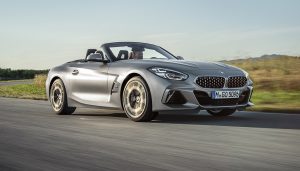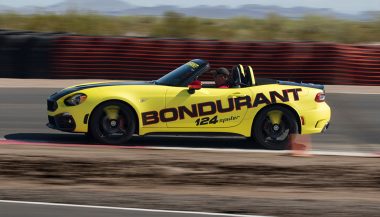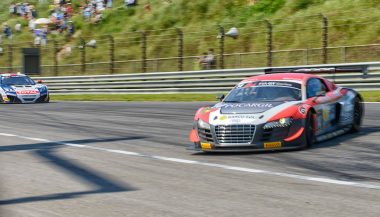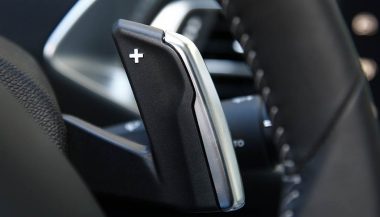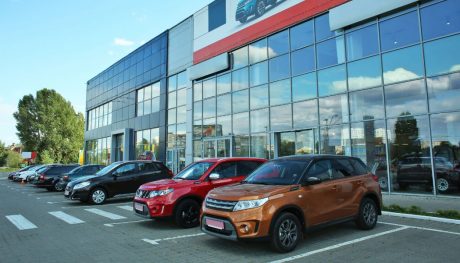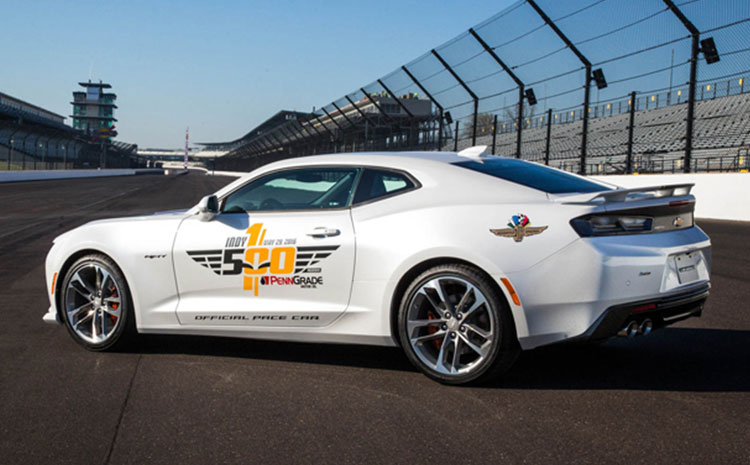
As the Indy 500 became more popular so did the demand to become the pace car driver and the provider of the actual Indy pace car.
Driving the Indy Pace Car
In 1911 Carl G. Fisher, a principal owner of the Indianapolis Motor Speedway, strapped himself into a Stoddard-Dayton (You laugh at the name? A Marmon Wasp won the race) and led that year’s race contestants to a rolling start. Previously auto races, like horse races, started from a standstill resulting in frequent collisions and other distractions before the race even got started. Fisher’s solution was to lead the racers around the track in a “pace car” keeping the racers in formation and then starting the race ‘on the go’ after a complete lap around the track.
Fisher was interested in safety; he was the one to first pave the Speedway with 3.2 million 10 pound bricks (it was previously ‘paved’ in crushed stone) but he was also the consummate promoter (he discovered Miami Beach and made a fortune in the Florida real estate boom of 1925) and knew that a lap around the track at a relatively slow speed gave the fans in the stand an opportunity to see their favorite car and driver at parade like speeds. The fans waved, the drivers waved back; it was great PR. As a side benefit it also allowed engines, oil, and tires to warm up.
100 years later in May 2016 Roger Penske, the owner of Team Penske, slid into a Chevy Camaro SS and led 33 racecars around the course before peeling off allowing the 100th race to start.
There Are Pace Car Drivers and Then There Are Pace Car Drivers
As the Indy 500 became more popular so did the demand to become the pace car driver and the provider of the actual pace car. Fisher acted as the driver for the first 5 years but then started making deals with big names in the automotive industry and celebrities for the coveted pace car driver slot. The basic requirements to become a pace car driver included having a valid driver’s license, an ability to drive at 70 mph and be a big enough draw to bring crowds to the track and inches of ink to newspapers and sports magazines.
Former pace car drivers included a mixed bunch as this sampling shows:
- Jackie Stewart
- James Garner
- Eddie Rickenbacker
- Chuck Yeager
- Carroll Shelby
- Parnelli Jones
- Jay Leno
- Morgan Freeman
- Colin Powell
- A. J. Foyt
And 85 others of similar fame.
A rolling start sounds like a good idea but it is not without its mishaps. Crashes and other mishaps have occurred 7 times since 1967 during the parade laps causing the yellow flag to appear and requiring the pace car to become something of a shepherd trying to maintain formation of his 33 car flock. Drivers don’t like yellow caution flags because for every extra lap they have to do they burn roughly a gallon of precious fuel. Consequently there is often maneuvering to push the pace car to go faster and to improve their position in the formation. That behavior can and does create other hazardous events that on at least two occasions drew the red flag to stop the race before it even starts.
So when a condition exists on the track that draws the yellow flag is it really safe to send out the former Secretary of State or a late night comedian back on the track in the pace car to slow the racecars down and keep them in their positions? That’s probably not a good idea.
Since 1979 there has been a second pace car driver who takes to the track during caution periods to keep order. The car used is frequently an exact replica of the ‘official’ pace car but the big difference is the experience and skill level of the driver. The caution pace car driver is a professional and for the last 10 years it has been three time Indy 500 winner Johnny Rutherford. Rutherford is also the pace car driver for all other Indy events at the Speedway.
So there are actually two pace car drivers, one for show and one for go.
There Are Pace Cars and Then There Are Pace Cars
With the exception of 1941 when Chrysler provided a show car, all pace cars have been production models. The obvious advantage for a manufacturer to provide a production model is they can turn around and sell replica pace cars (complete with decals) to their customers. GM has dominated the pace car business providing 54 of the 100 pace cars. Chevy Vettes and Camaros have been starting the race exclusively since 2002. Combined the Corvettes and Camaros have served as pace car 22 times with Stoddard-Dayton, Packard, LaSalle and Mustang coming in second with 3 appearances each.
So this year the pace car is a Camaro SS, a beautiful, sexy machine without pace car decals, but even more desirable with. This is a muscle car with agility and adjustable suspension. The 2016 Chevrolet Camaro SS packs a Corvette-sourced 6.2-liter V8 with 455 horsepower and 455 lb.-ft. of torque. With a short stroke six speed manual transmission and an exhaust that roars when you tap the pedal it’s easy to imagine leading 33 racecars around the Brickyard.
About those decals. The actual pace car used in the race is usually kept by the track or the manufacturer. Modifications have been made to the car like four point seat buckles and strobe lights to accommodate racing requirements although it’s not uncommon for other modifications to be made as well. So when you buy a replica you are buying the same type of car but not an exact copy.
The decals are mostly slapped on as a dealer modification except for a different class of vehicle known as Festival Cars. These are vehicles that the manufacturer provides the track for parades and other transportation tasks during the event. There may be upwards to 200 Festival cars and trucks assigned to the event and they will carry Indy decals. These vehicles will be sent to dealers requesting them for sales promotions. While there is no guarantee that these Festival Cars ever set foot on the track, they were used as work horses and transportation for the numerous parades that abound at the venue.
So what does a decal add to the value of a car? We could only find one that sold in 2014. It was a 1968 Ford Torino convertible (which right away tells you it was a Festival Car) with all the bona fides that it was purpose built for the race. This 47 year old Festival car went for $55,000. That’s a nice chunk of change but like all things, an item is worth only what someone is willing to pay for it.
Just as an aside, the 2016 Camaro SS starts at about $41,000 and nicely optioned will run a little over $47,000. We’re thinking that may be a better value than a 47 year old Ford Torino.

